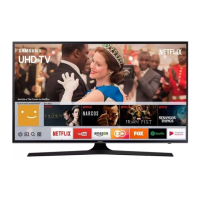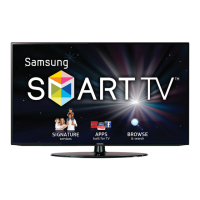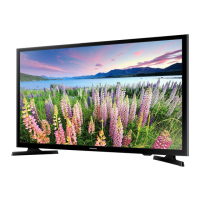••••
••••
••••
••••
: Auto
~Move
GEnter
"JReturn
DNS
.,=~
Network Setup
~
Internet Protocol Setup : Auto
Samsung's
Wireless
LAN
adapter
supports
the
IEEE
802.11
A,
IEEE
802.11
B,
IEEE
802.11
G,
and
IEEE
802.11
N
wireless
communication
protocols.
For
your
1V to
connect
to
your
network,
the
wireless
router
or
modem
you
use
must
also
support
one
of
these
protocols.
The
fastest
of
these
protocols
is
IEEE
802.11
N.
Most
wireless
network
systems
incorporate
a
security
system
that
requires
devices
that
access
the
network
through
an
access
point
or
AP
(typically
a
wireless
modem
or
router)
to
transmit
an
encrypted
security
code
called
an
access
key.
When
connecting
Samsung
Wireless
LAN
Adapter
to 1V
in
802.11
N
mode,
WEP/
TKIPITKIP-AES
is
not
supported.
You
can
enjoy
photo,
music,
and
movie
files
stored
on
a
USB
device
by
connecting
it
to
the
1V
and
using
the
Media Play
feature.
For
Media
Play
operating
instructions,
please
see
your
Owner's
Manual.
You
can
connect
your
1V to
your
LAN
through
a
standard
wireless
router
or
modem.
To
connect
wirelessly,
you
must
first
attach
a
"Samsung
Wireless
LAN
Adapter"
(WIS09ABGN
-
sold
separately)
to
either
the
USB
1
(HOD)
or
USB
2 port
on
the
back
of
your
1V.
See
the
illustration
below.
The
instructions
below
are
for
networks
that
use
the
Dynamic
Host
Configuration
Protocol
(DHCP)
to
configure
network
connections
automatically.
If
your
have
a
Static
IP
network,
see
your
user's
manual
for
configuration
instructions.
To
configure
your
network
connection
for
a
network
that
uses
DHCP,
follow
these
steps:
1.
Connect
your
1V to
your
network
as
shown
in
the
illustrations
above.
2.
Turn
on
your
1V,
press
the
MENU
button
on
your
remote,
and
the
select
Setup
-+
Network.
3.
Set
the
Network
Type
to Wireless
if it
is
not
already
set
to Wireless.
4.
Select
Network Setup.
The
Network Setup
screen
appears.
5.
On
the
Network Setup
menu,
select
an
AP(Access
Point)
and
ad
hoc
network.
if
you
have
selected
network
with
a
security
key,
the
Security
Key
screen
appears.
6.
Enter
the
security
key
using
the
numbers
on
the
remote,
and
then
press
the
Blue
button
on
your
remote.
~
If
your
network
uses
WEP
security encryption,
0-9
and
A-F
will
be
available
on
the
Security
Key
screen.
Use
the
Direction
button
on
your
remote
to
move
to
the
characters
and
the
enter
key
to
select
them.
7.
On
the
Network Setup
menu,
set
Internet Protocol Setup
and
DNS
to Auto.
The
Auto
acquires
and
enters
the
necessary
internet
values
automatically.
8.
Select
Network
Test
to
check
internet
connectivity.
~
For
more
information,
see
your
user's
manual.
Network Connection - Wireless
----------_..
__
.....
__
..
_-------------------------------------------------------------------------------------
••••
: Auto
~Move
GEnter
"JReturn
DNS
N~lw~rk·~
~
••••
••••
••••
To
view
the
On
Screen
Menus,
follow
these
steps:
1.
Turn
on
your
1V,
press
the
MENU
button
on
your
remote,
then
select
Application
-+
Content
View.
2.
Press
the
....
or
~
button
to
select
Internet@TV,
and
the
ENTER
~
button.
The
USER
TERMS
and
PRIVACY
POLICY
windows
appears,
then
select
Yes.
3.
Follow
the
directions
on
your
screen
to
set
up
Internet@1V.
For
detailed
instructions,
see
your
Owner's
Manual.
~
For
best
Internet@TV
results,
your
broadband
company
should
provide
sustained
download
speeds
of
3.5
mb/sec
or
more.
Most
home
networks
use
the
Dynamic
Host
Configuration
Protocol
(DHCP)
to
configure
network
connections.
Home
networks
that support
DHCP
automatically
provide
the
IP
address,
subnet
mask,
gateway,
and
DNS
values
your
1V
needs
to
access
the
Internet
so
you
don't
have
to
enter
them
manually.
To
configure
your
network
connection
for
a
network
that
uses
DHCP,
follow
these
steps:
1.
Connect
your
1V
to
your
network
as
shown
in
one
of
the
illustrations
above.
2.
Turn
on
your
1V,
press
the
MENU
button
on
your
remote,
and
then
select
Setup
-+
Network.
3.
Set
the
Network
Type
to
Wired
if it
is
not
already
set
to Wired.
4.
Select
Network Setup.
The
Network Setup
screen
appears.
5.
On
the
Network Setup
menu,
set
Internet Protocol Setup
and
DNS
to Auto.
Auto
acquires
and
enters
the
necessary
internet
values
automatically.
6.
Select
Network
Test
to
check
Internet
connectivity.
~
Some
networks
are
Static
IP
networks.
If
your
network
is
a Static
IP
network,
you
can
not
use
DHCP
to
configure
the
network connection.
Instead,
you
must
enter
the
IP
Address, Subnet Mask, Gateway,
and
DNS
Server
manually.
For
instructions
explaining
how
to
configure a Static
IP
network,
see
your
user's
manual.
~!~~i_~9_~~~~~~_~.~~J}'
_
There
are
two
main
ways
to
connect
your
1V
to
your
network
using
cable,
depending
on
your
network
setup.
They
are
illustrated
below:
Step
6:
The Internet@TV and Media Play Features
Your
TV's
Internet@1V
feature
lets
you
connect
to
an
ever-expanding
portal
of
your
favorite
on-line
digital
content.
Customizable
widgets
give
you
access
to
Blockbuster,
Facebook,
YouTube,
Flickr,
Netflix*
and
more
-
all
on
your
HDTV.
The
Media
Play
feature
lets
you
connect
to
your
PC
through
your
home
network
and
stream
PC
audio
and
video
files
to
your
HDTV
using
your
remote.
To
use
IPTV
or
Samsung
PC
Share
Manager,
you
must
connect
your
TV
to
your
network.
You
can
attach
the
1V
to
your
network
in
two
ways,
by
cable,
using
CAT
5
cable,
or
wirelessly,
using
a
Samsung
Wireless
LAN
Adapter.
Instructions
for
both
connection
methods
are
below.
Network Connection - Wired
--_
.._-------------------------------------------------------------------------------------------_.-----------
MEDIA.P:
Displays
Media
Play.
YAHOO!:
Runs
Yahoo
widget.
3D:
Sets
the
3D
mode.
FAV.CH:
Displays
Favorite
Channel
Lists
on
the
screen.
P.SIZE:
Selects
the
picture
size.
CC:
Controls
the
caption
decoder.
Displays
information
on
the
1V
screen.
Selects
the
on-screen
menu
items
and
changes
the
values
seen
on
the
menu.
Link
to
various
internet
services.
Exits
the
menu.
Returns
to
the
previous
channel.
Displays
channel
list
on
the
screen.
Changes
channels.
Cuts
off
the
sound
temporarily.
Change
the
channels
by
pressing
the
Channel
button
on
the
remote.
~
If
your
TV
is
attached
to
a
cable
or
satellite
box,
change
the
channel
using
the
box's
remote.
~~!~~_~~!~
__
~~~i.~~.P..I_':I_~
_
Auto
Motion
Plus
240HzTM
technology
virtually
eliminates
any
blur
in
video
that
include
fast
motion
such
as
sports
and
action
movies.
To
activate
Auto
Motion
Plus,
follow
these
steps:
1.
Turn
on
your
1V,
press
the
MENU
button
on
your
remote,
then
select
Picture
Options
-+
Auto Motion Plus
240Hz.
2.
Select
the
Auto Motion Plus
240Hz
setting
you
want.
~
If
noise
occurs
on
the
screen,
please
set
up
the
Auto Motion Plus
240Hz to Off.
If
Auto Motion Plus
240Hz
is
Custom,
you
can
set
up
the
Blur Reduction, Judder Reduction
or
Reset
manually.
~
If
Auto Motion Plus 240Hz
is
Demo,
you
can
compare
the
difference
of
on
and
off
modes.
3.
Press
the
RETURN
button
on
your
remote
when
done.
'V
MUTE
r¢
+
II
1 2
3
-II
4
5
6
7
8 9
~
-
WPRE~
I:0~O~
1 2 3
Returns
to
the
previous
menu.
Adjusts
the
volume.
Press
to
directly
access
channels.
Brings
up
the
OSD.
Displays
the
Content
View,
which
includes
Channel
List,
Internet@TV,
Media
Play,
AIIShare
and
3D
..
Quickly
select
frequently
used
functions.
Buttons
used
in
the
Channel list,
Internet@TV,
Media
Play
menu,
etc.
Press
to
select
additional
channels
(digital)
being
broad
casted
by
the
same
station.
For
example,
to
select
channel
"54-3",
press
"54",
then
press
"-"
and
"3".
Adjust
the
volume
by
pressing
the
Volume
button
on
the
remote.
Use
these
buttons
in
Media
Play
and
Anynet+
(HDMI-CEC)
modes.
(00:
Controls
recording
on
Samsung
recorders
that
have
the
Anynet+
feature)
To
watch
a
movie
on
your
Blu-ray
player
or
watch
your
favorite
1V
show,
you
must
select
the
correct
source.
A
source
is
a
device,
such
as
a
Blu-ray/DVD
player,
a
cable/satellite
box,
antenna
or
a
cable
1V
input.
Sources
can
be
connected
to
your
1V
through
the
HDMI,
DVI,
Component,
Composite,
or
D-sub
connections,
or
through
the
Antenna
or
Cable
In
connections.
To
view
the
signal
from
a
source
connected
to
the
HDMI,
DVI,
Component,
Composite,
or
D-sub
jack,
press
the
SOURCE
button
on
your
remote.
Each
time
you
press
the
SOURCE
button,
you
change
to a
different
source.
~~~~~!~~~--~-~~-~~~~------------_._._._--------------------------------------------------.-------
~~~~_s;J}_~9_~~~~~_~_I_~
__
~~~_~~i~~!~~_s;J
__
!~~_y?_I_~~~
. . . _
~
You
can
also
change
the
channels
by
pressing
the
v
CH
A button
on
the
front
panel
of
your
TV
and
adjust
the
volume
by
pressing
the
-
VOL
+ buttons.
(
POWER
ON/OFF
1
Turns
the
1V
on
and
off.
---11- 0
~O~CE
Q
---
Turns
the
remote
control
light
on
or
off.
When
on,
the
Displays
and
selects
the
available
video
sources.
buttons
become
illuminated
for
a
moment
when
pressed.
(Using
the
remote
control
with
this
button
set
to
off
will
reduce
the
battery
usage
time.)
yi_~~.i_~9_!_~_~_g_~_~£_~~~~_~_~~~~
_
To
view
the
On
Screen
Menus,
follow
these
steps:
II II
1.
Turn
on
your
1V,
press
the
MENU
button
on
your
CONTOO?
Imr
ET
remote.
The
main
menu
appears.
[]
.
T02LS
...
IN,FO
The
menu's
left
side
has
the
following
menu
""
options:
Picture, Sound, Channel, Setup, Input, Application,
and
Support.
2.
Press
the.
or
T
button
on
your
remote
to
select
a
menu
option,
and
then
press
the
ENTER~
button.
3.
When
done
using
the
menu,
press
the
EXIT
button
on
your
remote
to
exit.
Remote Control Buttons and Functions

